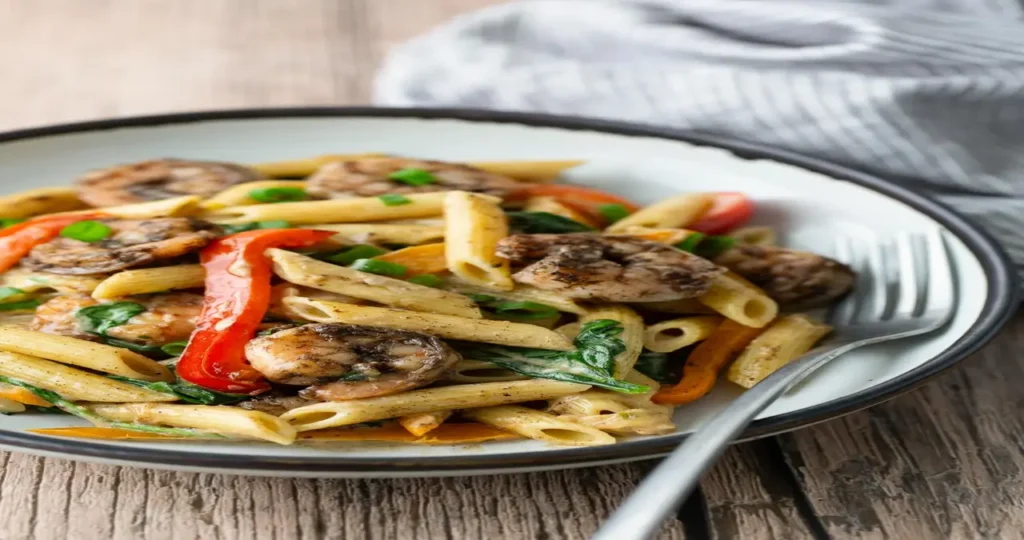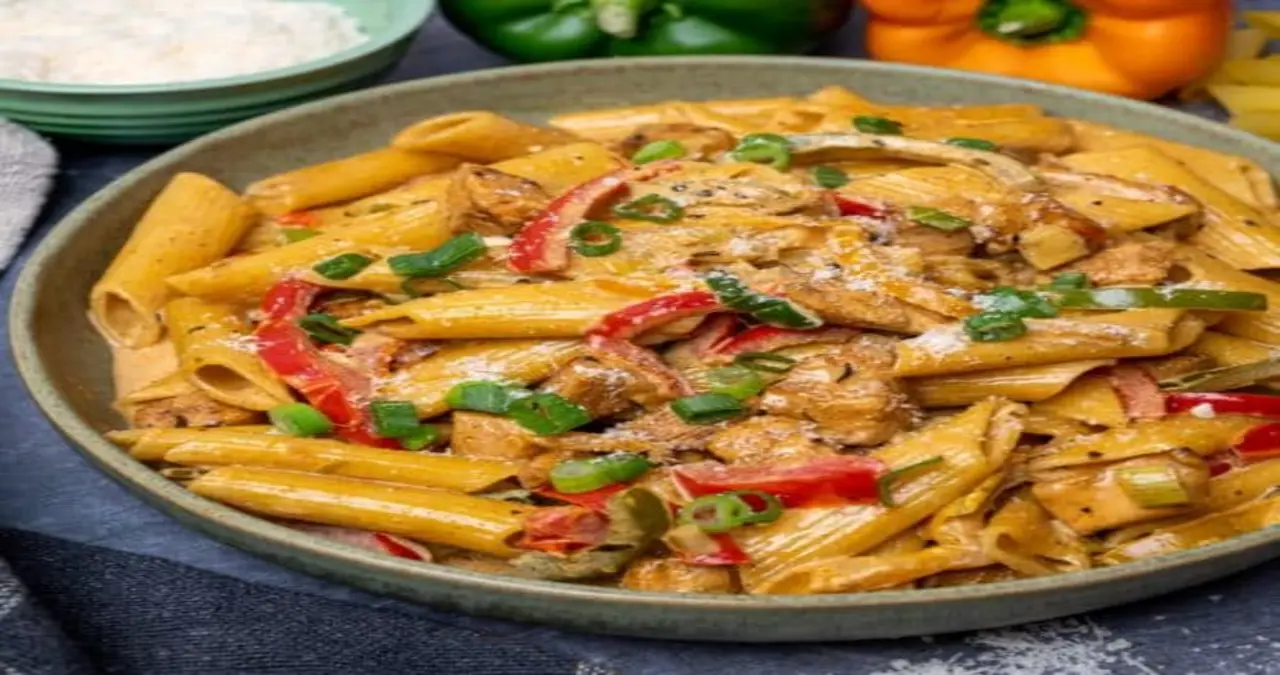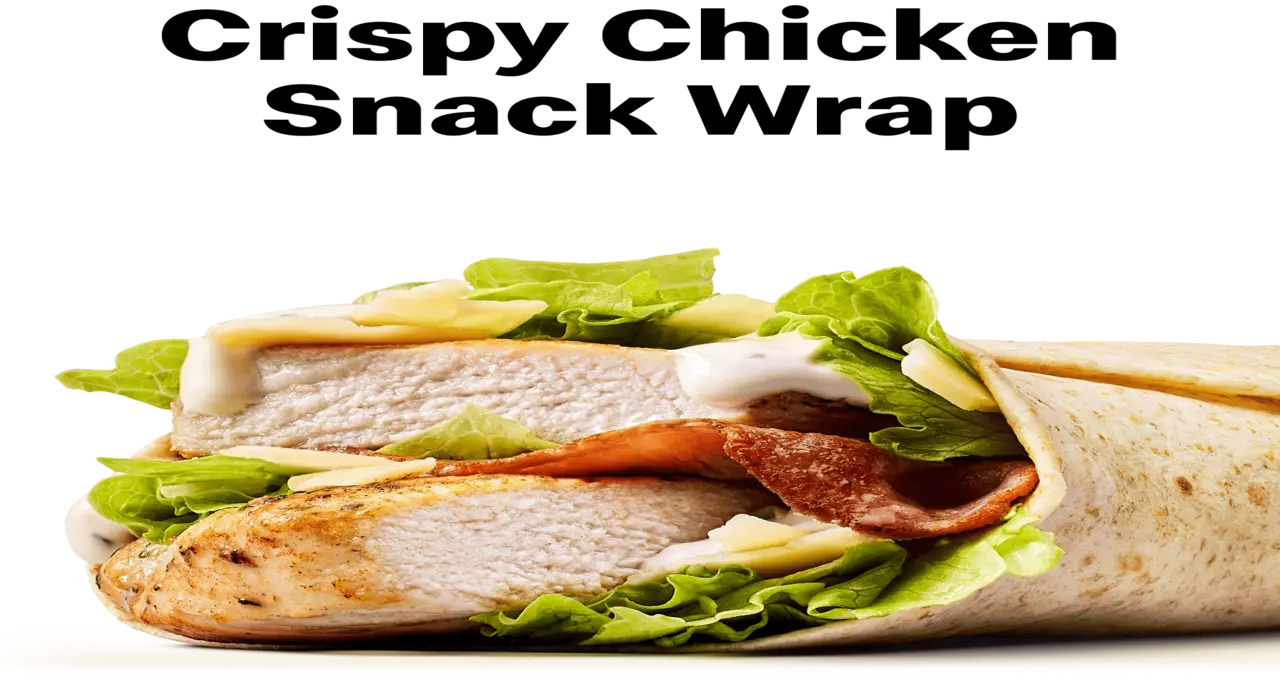Rasta Pasta If you love bold flavors, colorful plates, and dishes with a story, then you’re going to fall head over heels for rasta pasta. This flavorful and vibrant dish has roots in both Caribbean and Italian cuisine, blending the spicy, smoky flavors of jerk seasoning with creamy, cheesy pasta goodness. It’s the kind of dish that makes you want to dance in your kitchen while the aroma fills the air. Perfect for weeknight dinners, family gatherings, or impressing your friends, rasta pasta is more than just a meal—it’s a vibe.
What is Rasta Pasta?
Rasta pasta is a unique, flavorful dish that combines the richness of Italian pasta with the bold, spicy flavors of Jamaican jerk seasoning. The result is a colorful, creamy, and slightly spicy meal that’s incredibly satisfying. Typically made with penne or fettuccine, rasta pasta includes bell peppers, jerk-seasoned chicken, shrimp, or tofu, and a creamy sauce infused with Caribbean spices.
The dish gets its name from the colors of the vegetables, which mirror the traditional Rastafarian colors of red, green, and yellow. Even though not all Rastafarians eat meat or dairy, the dish has become a beloved staple in many Caribbean households and restaurants. Rasta pasta is known for its versatility and can be made to suit a wide range of dietary preferences.
It’s not just the flavor that makes rasta pasta stand out, but the story behind it too. The fusion of cultures represented in this dish is a testament to how food can bring people and traditions together, creating something new and exciting. When you plate up a serving of rasta pasta, you’re not just enjoying a delicious meal—you’re tasting a little piece of culinary history.
The Origins of Rasta Pasta
Rasta pasta might seem like a modern creation, but its roots go deeper than you might expect. The dish was first created by Jamaican chef Lorraine Washington in the 1980s. It all started when she served fettuccine tossed with vegetables and jerk seasoning to a group of Rastafarian musicians visiting her hotel kitchen. They loved it so much that it quickly became a popular request.
What made rasta pasta so special was its unexpected yet perfect blend of Caribbean spices with a traditional Italian dish. The vibrant colors from the bell peppers and the distinctive jerk flavors made it a hit, and it wasn’t long before it spread beyond Jamaica to other Caribbean communities around the world.
Today, rasta pasta is a staple on many Caribbean restaurant menus and a favorite among home cooks who love experimenting with flavors. The dish continues to evolve, with people adding their twists—swapping chicken for shrimp, tofu, or plant-based meats, and experimenting with different types of pasta and sauce variations. It’s one of those dishes that never really goes out of style because there’s always a new way to enjoy it.
Ingredients That Make Rasta Pasta Special
One of the best things about rasta pasta is how easy it is to customize. While the core ingredients remain consistent, you can easily tailor it to suit your tastes and dietary needs. Here’s a closer look at what goes into making this delicious dish.
At the heart of rasta pasta is the jerk seasoning. This spice mix usually includes a blend of allspice, thyme, cinnamon, nutmeg, garlic, and scotch bonnet peppers, giving the dish its unmistakable heat and depth of flavor. You can find pre-made jerk seasoning in stores, but making your own allows you to control the heat and spice levels.
The pasta is typically penne or fettuccine, though you can use whatever you have on hand. The bell peppers play a starring role, adding color and sweetness that balances the spiciness of the jerk seasoning. Red, yellow, and green bell peppers are used to reflect the Rastafarian colors, making the dish as beautiful as it is tasty.
The protein can be anything you like—jerk chicken is the most popular, but Rasta Pasta, tofu, and even plant-based proteins work wonderfully. The creamy sauce is made with heavy cream, parmesan, and sometimes cream cheese, creating a rich, velvety texture that brings everything together.
Other optional add-ins include onions, garlic, scallions, and fresh herbs like parsley or cilantro. Some recipes even call for coconut milk instead of cream for a lighter, dairy-free version with a hint of tropical sweetness.

How to Make Rasta Pasta at Home
Making rasta pasta at home is surprisingly simple and doesn’t require any fancy equipment or ingredients. It’s one of those dishes that feels gourmet but comes together in under an hour. Here’s a basic guide to get you started.
Start by seasoning your protein with jerk seasoning. If you’re using chicken, cut it into bite-sized pieces and let it marinate for at least 30 minutes. For shrimp or tofu, a shorter marination time is fine. While your protein is marinating, cook your pasta according to package directions, making sure to reserve a little pasta water before draining.
In a large skillet, heat some oil and cook your protein until it’s nicely browned and cooked through. Remove it from the pan and set it aside. In the same skillet, sauté your sliced bell peppers, onions, and garlic until they’re tender but still vibrant.
Pour in the cream and stir in the parmesan cheese, letting it melt and create a silky sauce. If the sauce is too thick, add a splash of reserved pasta water to loosen it up. Return the cooked protein to the skillet, then toss in the cooked pasta, making sure everything is well coated.
Finish with fresh herbs and extra parmesan if you like, then serve it up while it’s still hot and creamy. Rasta pasta is one of those dishes that’s even better the next day, so don’t hesitate to make a little extra.
Variations and Twists on Classic Rasta Pasta
One of the coolest things about rasta pasta is how endlessly customizable it is. While the classic version features jerk chicken and cream sauce, there’s no shortage of creative ways to make this dish your own.
For a seafood twist, try using shrimp or scallops in place of chicken. The natural sweetness of seafood pairs beautifully with the spicy, creamy sauce. If you’re vegetarian or vegan, swap the meat for tofu, tempeh, or your favorite plant-based protein. Coconut milk can replace the cream with a dairy-free version, and nutritional yeast can stand in for parmesan.
Some cooks like to use different types of pasta, like rotini, linguine, or even spaghetti. You can also load up your rasta pasta with extra veggies like mushrooms, spinach, or zucchini for added nutrition and color. Another fun variation is adding pineapple chunks, which lend a sweet, tropical touch that balances the heat of the jerk seasoning.
If you like things extra spicy, don’t be shy about adding more scotch bonnet peppers or a dash of hot sauce. On the flip side, if you’re not a fan of too much heat, you can mellow out the jerk seasoning by adjusting the spice blend to suit your preference. That’s the beauty of rasta pasta—it’s all about making it work for you.
Why You Need Rasta Pasta in Your Life
If you’ve never tried rasta pasta before, you’re seriously missing out. This dish is more than just a fusion of flavors—it’s a celebration of culture, creativity, and comfort food at its finest. The combination of spicy jerk seasoning, creamy sauce, and tender pasta creates a dish that’s bold, comforting, and completely unforgettable.
Rasta pasta is also incredibly versatile, making it perfect for a wide range of occasions. Whether you’re hosting a casual dinner with friends, meal prepping for the week, or looking for something special to serve at a family gathering, this dish delivers every time. Plus, it’s easy to adjust for different dietary preferences, so everyone at the table can dig in.
And let’s not forget how fun it is to make. Between the colorful veggies, sizzling protein, and rich, creamy sauce, cooking rasta pasta is an experience in itself. It’s the kind of dish that makes you want to turn up the music, pour a drink, and enjoy the process. Once you’ve tried it, you’ll see why so many people have fallen in love with this flavorful Caribbean-Italian classic.



